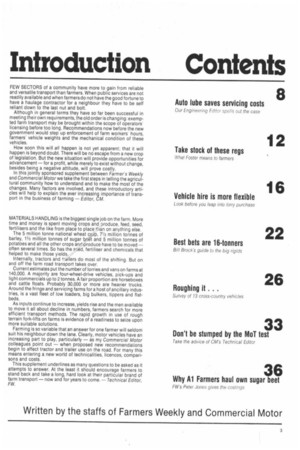FEW SECTORS of a community have more to gain from
Page 119

If you've noticed an error in this article please click here to report it so we can fix it.
reliable and versatile transport than farmers. When public services are not readily available and when farmers do not have the good fortune to have a haulage contractor for a neighbour they have to be self reliant down to the last nut and bolt.
Although in general terms they have so far been successful in meeting their own requirements, the old order is changing: exempted farm transport may be brought within the scope of operators' licensing before too long. Recommendations now before the new government would step up enforcement of farm workers hours, farmers' vehicle weights and the mechanical condition of these vehicles.
How soon this will all happen is not yet apparent: that it will happen is beyond doubt. There will be no escape from a new crop of legislation. But the new situation will provide opportunities for advancement — for a profit, while merely to exist without change, besides being a negative attitude, will prove costly.
In this jointly sponsored supplement between Farmer's Weekly and Commercial Motor we take the first steps in telling the agricultural community how to understand and to make the most of the changes. Many factors are involved, and these introductory articles will help to explain the ever increasing importance of transport in the business of farming — Editor, CM.
MATERIALS HANDLING is the biggest single job on the farm. More time and money is spent moving crops and produce, feed, seed, fertilisers and the like from place to place t!ian on anything else.
The 5 million tonne national wheat c,pp, 71/2 million tonnes of barley, 11/2 million tonnes of sugar ly,4t and 5 million tonnes of potatoes and all the other crops ane/produce have to be moved — often several times. So has the s'..ed, fertiliser and chemicals that helped to make those yields.
Internally, tractors and t-ailers do most of the shifting. But on and off the farm road transport takes over.
Current estimates put the number of lorries and vans on farms at 140,000. A majority are four-wheel-drive vehicles, pick-ups and light commercials up to 2 tonnes. A fair proportion are horseboxes and cattle floats. Probably 30,000 or more are heavier trucks. Around the fringe and servicing farms for a host of ancillary industries, is a vast fleet of low loaders, big bulkers, tippers and flatbeds.
As inputs continue to increase, yields rise and the men available to move it all about decline in numbers, farmers search for more efficient transport methods. The rapid growth in use of rough terrain fork-lifts on farms is evidence of a readiness to seize upon more suitable solutions.
Farming is so variable that an answer for one farmer will seldom suit his neighbour down the lane. Clearly, motor vehicles have an increasing part to play, particularly — as my Commercial Motor colleagues point out — when proposed new recommendations begin to affect tractor and trailer use on the road. For many this means entering a new world of technicalities, licences, comparisons and costs.
This supplement underlines as many questions to be asked as it attempts to answer. At the least it should encourage farmers to stand back and take a long, hard look at their particular brand of farm transport — now and for years to come. — Technical Editor, FW.




























































































































































